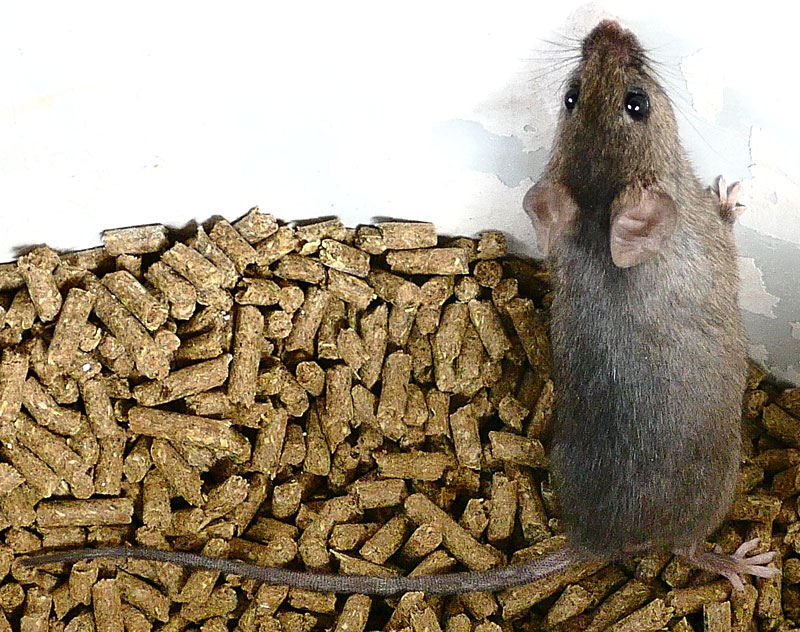Excerpts from Jim Conrad's
Naturalist Newsletter
entry dated December 17, 2022, issued from near Tequisquiapan, elevation about 1,900m (6200 ft), N20.565°, W99.890°, Querétaro state, MÉXICO
WESTERN HARVEST MOUSE

At the edge of a small village with open fields nearby on one side, a friend keeps rabbits in a pen with a dirt floor. For some time my friend has been telling me about a kind of unusually small mouse that at night habitually removes rabbit food-pellets from the food bucket. One morning one of these mice had become trapped inside the bucket, and my friend took the above picture.
That fine picture shows some valuable field marks, including the tail being longer than the body, the hind legs being gray with white toes, and you can see the relative size of the hairless ears to that of the head, and the body color. One needs all the field marks possible because several species found here are very similar. Just seeing the above picture, I doubt that a specialist could have confidently identified the critter to species level.
Fortunately, the mammal section of the Historia Natural de Querétaro, edited by Robert Jones and Valentina Serrano Cárdenas and published in 2016, is available online, listing all known mammals of Querétaro state. In the rodent section, the family Cricetidae, embracing mice, rats, and similar groups, 22 species are listed in various genera. However, with the above photo I couldn't even be sure which genus we had.
Then one morning my friend appeared at the door with a cat-mauled miniature mouse from his rabbit pen. At least the rear end of the creature was intact enough for the following picture, the ruler being metric:

Now I could measure features important for mouse identification. The whole body, tail included, was 155mm long (6.1 inch). The tail was 82mm long (3.3inch), and just the body with the snout projecting forward was 73mm (2.9inch).
By comparing pictures of each species with those on the Internet, and -- more decisively -- comparing the measurements given above, by the process of eliminating all but one of the 22 species, I was led to what's often referred to as the Western Harvest Mouse, REITHRODONTOMYS MEGALOTIS.
On the gbif.org website page for Reithrodontomys megalotis the distribution map shows that the species mainly occurs in the western US, but also southwestern Canada, and nearly throughout Mexico south to the Guatemalan border, but not in the Yucatan. Also on that page, the notes make clear that this is an adaptable species, occurring from 76m (250ft) below sea level in Death Valley, to about 3500m (11,500ft) high, mostly found in grasslands, weedy areas and among shrubs. Significantly for us, the animaldiversity.org page for the species also mentions its occurrence in urban, suburban and agricultural areas.
Most pictures of the Western Harvest Mouse on the Internet, primarily taken in the US, show individuals with whiter undersides and legs. However, currently 15 subspecies are recognized, and some authorities think that separate species may be included in the current concept of what Reithrodontomys megalotis is. The animaldiversity.org website remarks that fur on the belly ranges from white to deep gray, so our dark-bellied ones are allowed, and a few pictures of the species show coloration just like ours.
At the above two links there's considerable life history information. For example, Reithrodontomys megalotis is "polygynous," for dominant male mice mate with several females at one time. The gestation period is only 23-25 days, and a mother can produce from about 4 to 9 pups at one time. The pups leave their nests in about 3 weeks. Young mice reach sexual maturity in only about a month of age. Most individuals live no longer than a year. One gets the impression that life for these mice is dangerous and short.
The species is territorial, and active at night, mostly before midnight. In the wild they travel through grass using known runways. In my friend's rabbit pen, there are plenty of old rabbit burrows, mouse-size cracks in the stone wall on two sides, and there's a mouse-size hole in the ground right beside the bucket with rabbit pellets. In the wild, they mostly eat seeds but also plant parts and invertebrate animals. In the rabbit pen there's also hay to eat and the occasional carrot and other vegetables.
My friend's mice seem to have stumbled into a comfortable lifestyle, except for the neighborhood cats, who also occasionally feed on young rabbits.